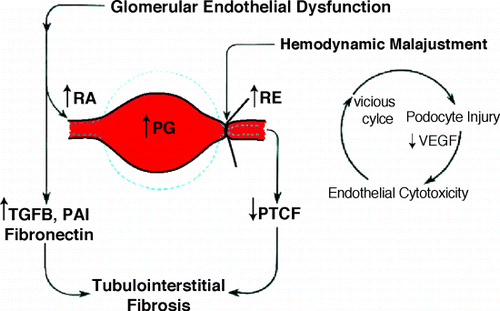Two special issues that are relevant to the progression of chronic kidney disease (CKD) are the failure of early detection of tubulointerstitial fibrosis (TIF) and the unsettled pathogenesis of renal disease progression (RDP). With respect to the former, an early detection of TIF can be achieved by using a determination of fractional excretion of magnesium (FE Mg), which correlates directly with TIF since it reflects the tubular reabsorptive capability and intratubular wastage of magnesium in association with tubulointerstitial injury.Citation[1] FE Mg is normal in minimal change disease or in acute glomerulonephritis with intact tubulointerstitial structure and is consistently elevated in conditions associated with TIF namely FSGS, IgM nephropathy with TIF, IgA N, reflux nephropathy, severe lupus nephritis, chronic glomerulonephritis and diabetic nephropathyCitation[2] (unpublished data).
In accordance with the pathogenesis of RDP, a hemodynamically mediated mechanism has recently been proposed. In essence, an injury to the vascular compartment of the nephron (glomerular and postglomerular capillary) is usually associated with the initiation of a variety of glomerular diseases and has recently been documented that the glomerular endothelial dysfunction in respect to the reduction in renal perfusion precedes the development of TIF.Citation[3] Indeed, an altered intrarenal hemodynamics so called hemodynamic maladjustment has been uniquely observed in a variety of CKDs.Citation[4], Citation[5], Citation[6], Citation[7] It is characterized by a preferential constriction at the efferent arteriole by which it induces 1) proximally; the intraglomerular hypertension, capillary ballooning and podocyte injuryCitation[8], Citation[9], Citation[10], Citation[11] which aggravates in a vicious cycle pathogenesis () and 2) distally; exaggeratedly reduces the peritubular capillary flow which not only induces ischemic injury but also activates the profibrogenic pathway and therefore culminate in TIF.Citation[12], Citation[13], Citation[14], Citation[15] A therapeutic correction of hemodynamic maladjustment with much higher doses of multi‐drugs (vasodilators) than needed for maximal blood pressure control; has been repeatedly achieved to restore renal function with improved renal perfusion, GFR and prevent the RDP in CKD.Citation[8], Citation[16], Citation[17], Citation[18]
Figure 1. PG = intraglomerular hydrostatic pressure, PTCF = peritubular capillary flow, RA = afferent arteriole, RE = efferent arteriole, RPF = renal plasma flow. (View this art in color atwww.dekker.com.)

References
- Futrakul P., Yenrudi S., Futrakul N., Sensirivatana R., Kingwatanakul P., Jungthirapanich J., Cherdkiadtikul T., Laohapaibul A., Watana D., Singkhwa V., Futrakul S., Pongsin P. Tubular function and tubulointerstitial disease. Am. J. Kidney Dis. 1999; 33: 886–891, [PUBMED], [INFOTRIEVE]
- Futrakul N., Pochanugool C., Sitprija V., Futrakul P., Yenrudi S., Sensirivatana R., Watana D., Poshyachinda M. Renal dysfunctions in glomerulonephropathy with rapidly declined renal failure. Ren. Fail. 1996; 18: 557–565, [PUBMED], [INFOTRIEVE], [CSA]
- Futrakul N., Yenrudi S., Sensirivatana R., Watana D., Laohapaibul A., Watanapenphaibul K., Kingwatanakul P., Futrakul P., Futrakul S. Peritubular capillary flow determines tubulointerstitial disease in idiopathic nephrotic syndrome. Ren. Fail. 2000; 22: 329–335, [PUBMED], [INFOTRIEVE], [CSA], [CROSSREF]
- Scandling J. S., Black V. M., Deen W. M., Meyers B. D. Glomerular permselectivity in healthy and nephrotic humans. Adv. Nephrol. 1992; 21: 159–176
- Futrakul P., Poshyachinda M., Mitrakul C. Focal sclerosing glomerulonephritis: a kinetic evaluation of hemostasis and the effect of anticoagulant therapy: a controlled study. Clin. Nephrol. 1978; 10: 180–186, [PUBMED], [INFOTRIEVE]
- Futrakul P., Poshyachinda M., Yenrudi S., Saleekul P., Sensirivatana R., Futrakul N., Apaiwong S., Pochanugool C., Thamaree S., Buranasiri K., Watana D., Kingwatanakul P., Panichpun S., Kwoepaitoon S., Tiromparin C. Intrarenal hemodynamic abnormality in severe form of glomerulonephritis: therapeutic benefit with vasodilators. J. Med. Assos. Thail. 1992; 75: 375–385
- Campbell R., Sangalli F., Perticucci E., Aros C., Viscarra C., Perna A., Remuzzi A., Bertocchi F., Fagiani L., Remuzzi G., Ruggenenti P. Effects of combined ACE inhibitor and angiotensin II antagonist treatment in human chronic nephropathies. Kidney Int. 2003; 63: 1094–1103, [PUBMED], [INFOTRIEVE], [CROSSREF]
- Kriz W., Elger M., Nagata M., Kretzler M., Uiker S., Koeppen‐Hazemann I., Tenschert S., Lemley K. V. The role of podocytes in the development of gloemrulosclerosis. Kidney Int. 1994; 45(suppl. 45)64–72
- Fogo A. Nephrotic syndrome: molecular and genetic basis. Nephron 2000; 85: 8–13, [PUBMED], [INFOTRIEVE], [CSA], [CROSSREF]
- Rennke H. G. How does glomerular epithelial injury contribute to progressive glomerular damage?. Kidney Int. 1994; 45(suppl. 45)58–63
- Futrakul N., Siriviriyakul P., Panichakul T., Butthep P., Patumraj S., Futrakul. Glomerular endothelial cytotoxicity and dysfunction and immunocirculatory defect in nephrosis with focal segmental glomerulosclerosis. Clin. Hemorheol. Microcirc. 2003; 29: 469–473, [PUBMED], [INFOTRIEVE]
- Ruiz‐Ortega M., Egido J. Angiotensin II modulates cell growth‐related events and synthesis of matrix proteins in renal interstitial fibroblasts. Kidney Int. 1997; 52: 1497–1510
- Bottinger E. P., Bitzer M. TGF‐B signaling in renal disease. J. Am. Soc. Nephrol. 2002; 13: 260–269, [CSA], [CROSSREF]
- Fogo A. B. The role of angiotensin II and plasminogen activator inhibitor‐1 in progressive glomerulosclerosis. Am. J. Kidney Dis. 2000; 35: 179–188, [PUBMED], [INFOTRIEVE]
- Wei Z., Costa K., Al‐Medhi A. B., Dodia C., Muzykantor V., Fisher A. B. Simulated ischemia in flow‐adapted endothelial cells lead to generation of reactive oxygen species and cell signaling. Circ. Res. 1999; 85: 682–689, [PUBMED], [INFOTRIEVE]
- Komine N., Khang S., Wead L. M., Blantz R. C., Gubbar F. B. Effect of combining an ACE inhibitor and angiotensin II receptor blocker on plasma and kidney tissue giotensin II levels. Am. J. Kidney Dis. 2002; 39: 159–164, [PUBMED], [INFOTRIEVE]
- Futrakul N., Tohsukhowong P., Patumraj S., Siriviriyakul P., Tipprukmas N., Futrakul P. Treatments of hemodynamic maladjustment and oxidative stress prevent renal disease progression in chronically severe glomerulonephritides. Ren. Fail. 2003; 25: 839–844, [PUBMED], [INFOTRIEVE], [CSA], [CROSSREF]
- Futrakul N., Tosukhowong P., Valyapongpichit Y., Tipprukmas N., Futrakul P., Patumraj S. Oxidative stress and hemodynamic maladjustment in chronic renal disease: a therapeutic implication. Ren. Fail. 2002; 24: 433–445, [PUBMED], [INFOTRIEVE], [CSA], [CROSSREF]
